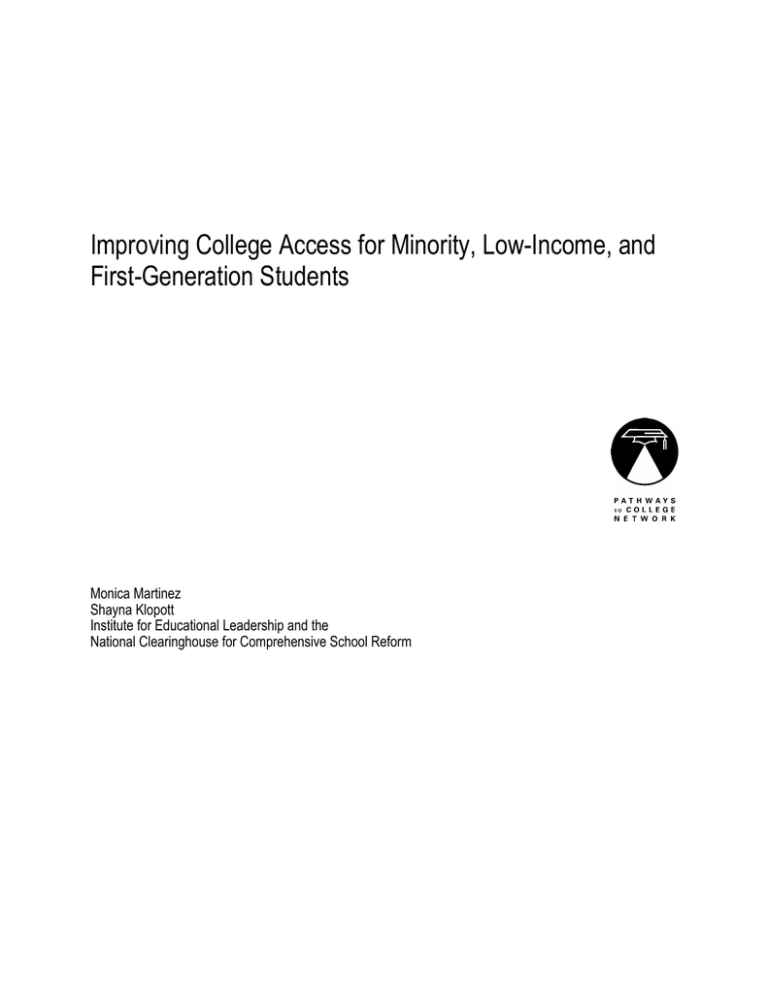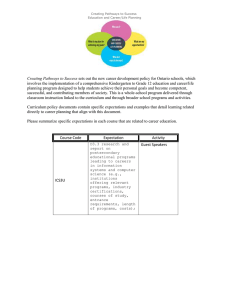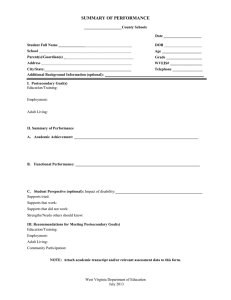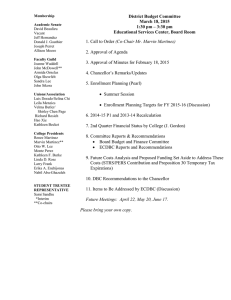
Improving College Access for Minority, Low-Income, and
First-Generation Students
Monica Martinez
Shayna Klopott
Institute for Educational Leadership and the
National Clearinghouse for Comprehensive School Reform
The Pathways to College Network is an alliance of major foundations, non profit organizations, educational institutions,
and the U.S. Department of Education, working together to improve college access and success for large numbers of
underserved youth.
The Education Resources Institute (TERI) was founded in 1985 to provide education financing and
information services to students and their families. As a private, not-for-profit organization, TERI recognizes
that middle-income Americans are increasingly excluded from traditional financial aid programs. To help fill
the financial aid gap, TERI offers loans based on creditworthiness, not income limitations.
Copyright © 2003. All rights reserved. Printed in the United States of America.
Published by the Pathways to College Network Clearinghouse.
Copies are available from the Pathways to College Network Clearinghouse.
Pathways to College Network Clearinghouse
Educational Opportunity Clearinghouses
Pell Institute for the Study of Opportunity in Education
1025 Vermont Ave. NW, Suite 1025
Washington, DC 20005
Telephone: 202-638-2887
Fax: 202-638-3808
Electronic copies in PDF format can be downloaded at http://www.pathwaystocollege.net
Pathways to College Network
th
31 St. James Ave., 6 Floor
Boston, MA 02116
Telephone: 617- 556-0535
Fax 617-422-8841
http://www.pathwaystocollege.net
Table of Contents
Introduction......................................................................................................................... 1
Recommendation 1: Raise Expectations for Students ........................................................ 4
Recommendation 2: Provide Academic Support................................................................ 6
Recommendation 3: Improve Social Support for Students ................................................ 8
Recommendation 4: P-16 Alignment ............................................................................... 10
Recommendation 5: Make Quality Evaluations a Component of All New Efforts….......11
Conclusion ........................................................................................................................ 13
Citations ............................................................................................................................ 14
1
Introduction
The purpose of this paper is to synthesize the recommendations made in four
white papers commissioned by the Pathways to College Network focused on elements
that lead to increased access to college for minority, low-income, and first-generation
students. These papers are: “How Do Educators’ Cultural Belief Systems Affect
Underserved Students’ Pursuit of Postsecondary Education?” co-authored by Pat George
and Rosa Aronson from the National Association of Secondary School Principals
(NASSP); “How is School Reform Tied to Increasing College Access and Success for
Low-Income and Minority Youth?” co-authored by Monica Martinez and Shayna Klopott
from the Institute for Educational Leadership (IEL); “How do Pre-Collegiate Academic
Outreach Programs Impact College-Going Among Underrepresented Students?” coauthored by Yvette Gullatt and Wendy Jan from the University of California, Office of
the President (UCOP); and “The Middle Grades: Putting All Students on Track for
College” by Dr. Sharon Camblin. The four papers identify a common problem: the
current structure of middle and high schools is inadequate to prepare minority, lowincome, and first-generation students to attend college. Although each paper examines a
different cause of this disjuncture, each comes to the conclusion that a successful change
will require significant transformation in secondary education, and possibly a complete
overhauling of the P-16 existing system.
The paper, “How Do Educators’ Cultural Belief Systems Affect Underserved
Students’ Pursuit of Postsecondary Education?” examines the relationship between
educators’ cultural beliefs—an individual’s ways of viewing the world based on cultural
norms and expectations—and underserved students’ pursuit of postsecondary education.
2
It argues that many, if not most teachers are unprepared to work with the diverse students
that fill today’s schools. The authors contend that, although generally unconsciously,
educators frequently alter their expectations of students’ abilities and achievement based
on their race, gender, socio-economic status, and other such demographic characteristics,
and that they are, consequently, less likely to present advanced work to such students.
Additionally, differential cultural expectations and understandings of learning styles and
student, teacher, and family roles, often lead to a disconnect between schools and
families/communities and limit the effects of classroom learning, as students see fewer
connections to the “real world.”
The paper, “How is School Reform Tied to Increasing College Access and
Success for Low-Income and Minority Youth?” examines the predictors of college-going
behavior and explores the ways in which a number of high school reform efforts address
those predictors. It concludes that, while most high school reform efforts were not
primarily designed to increase college access, many of them have incorporated practices,
such as increased academic press and a greater provision of support structures for
students that research suggests improve the likelihood that underrepresented minority and
low-income youth will successfully enroll in, and complete, college. Martinez and
Klopott find that the most common elements of the reform initiatives include access to a
common core academic curriculum for all students, a balance of academic and social
support for the purpose of developing social networks and instrumental relationships, the
use of small or personalized learning environments, and the alignment of curriculum
between and among various levels.
3
The paper, “How do Pre-Collegiate Academic Outreach Programs Impact
College-Going among Underrepresented Students?” identifies the characteristics of
practices that comprise effective programs, and the implications that they have for further
development of pre-collegiate academic development programs and for school reform.
The authors conclude that most pre-collegiate outreach programs are designed to counter
the effects of negative school and/or lack of community resources and influences that
inhibit student learning and goal-setting. This is called the deficit-building model. Gullatt
and Jan find 10 principles of practice that are exemplified in strong pre-collegiate
outreach programs designed according to the deficit-building model: (1) high standards
for program students and staff; (2) personalized attention for students; (3) adult role
models; (4) peer support; (5) K-12 program integration; (6) strategically timed
interventions; (7) long-term investment in students; (8) school/society bridge for students;
(9) scholarship assistance; and (10) evaluation designs that contribute results to
interventions (Gullat & Jan, 2002). The most successful pre-collegiate programs, they
contend, are developed around these principles and provide experiences that enable
underrepresented youth to successfully enroll in college.
The paper, “The Middle Grades: Putting All Students on Track for College” seeks
to answer four critical questions: (1) what is the relationship between the middle grades
and college access; (2) how can middle grade schools mitigate the challenges faced by
the underserved student; (3) what are the capacities that middle grade schools need in
order to ensure college access for the underserved student; and (4) how can middle grade
schools develop those capacities? The author argues that it is during the middle grades
that students need to begin to develop college awareness/predisposition and to begin to
4
plan for college by ensuring that their academic plans are well aligned to college
enrollment requirements and by developing an understanding that college is possible,
even for students who don’t come from traditional college-going families. Additionally,
the author contends that it is the job of the middle grades school to provide both students
and their families with the counseling and activities to develop this awareness and
planning and to provide the academic rigor and support to make college access a
possibility. Finally, the author suggests that middle grades schools need to develop clear
standards, high expectations, and school structures that meet students’ needs.
Each of the four papers concluded with a series of recommendations. Although
the language varied from paper to paper, there was significant commonality among the
four papers. Overall, there were 13 unique recommendations made to address the
inadequate collegiate preparation of minority, low-income, and first-generation students.
Using the 13 original recommendations, we provide five synthesized recommendations
with concrete examples for achieving each one.
Recommendation 1: Raise Expectations for Students
Research on the relationship between teachers’ expectations and student performance
indicates that teachers’ judgments and expectations of student ability influence student
performance (Alvidrez & Weinstein, 1999; Jussim & Eccles, 1992; Anyon, 1980).
Therefore, creating an environment in which students are expected to achieve at high
levels and where they are encouraged and supported in doing so is a critical means of
preparing students for college attendance.
5
•
Require all students to take an academically rigorous core curriculum. Providing
access to such a curriculum sends teachers and students a message that all
students can complete high-level work (Martinez & Klopott, 2002; George &
Aronson, 2002; Camblin, 2003).
•
Instill the expectation of college readiness in students as early as the middle
grades to ensure that they begin to develop college and career aspirations, as well
as to create an appropriate academic plan (Camblin, 2003).
•
Instill the expectation among staff and faculty that college preparation will be a
goal for every student. In turn, students will work harder, internalize the
expectation, and consequently work toward college enrollment as a personal goal
(Martinez & Klopott, 2002; George & Aronson, 2002; Camblin, 2003).
•
Address the cultural beliefs of school staff. Teachers should work to recognize
their own cultural beliefs and understand how those beliefs might affect their
pedagogy and their interactions with students. Once aware of their biases,
teachers are able to change their practices and more effectively meet the needs of
their students (George & Aronson, 2002; Camblin, 2003).
•
Incorporate students’ cultural, linguistic, and historical knowledge into the
curricula and activities of the school. In doing so students will see their culture
and language as assets and will become more engaged in the teaching and
learning process (George & Aronson, 2002; Gullat & Jan, 2002; Camblin, 2003).
•
Teach higher order skills to all students as opposed to developing memorization
and skills. When students are placed in classrooms that provide more intense,
varied, and authentic instructional experiences (knowledge construction and
6
relevance) they demonstrate the ability to master more complex and demanding
tasks (Newman & Wehlage, 1996; Martinez & Klopott, 2002; George &
Aronson, 2002; Camblin, 2003).
•
Work with families and postsecondary institutions to create high expectations
and clear pathways to postsecondary education. Parental support and knowledge
of the college-going process is crucial to helping students attain bachelor’s
degrees. By working with both parents and postsecondary institutions, high
schools can assure that parents have the information that their children need to
attend college (Martinez & Klopott, 2002; Gullat & Jan, 2002; Camblin, 2003).
Recommendation 2: Provide Academic Support
One of the most important components of college preparation is the provision of
strong academic support. Research shows that students who take high-level courses,
including advanced mathematics in high school, are more likely to enroll in and complete
bachelor’s programs than those who do not (Adelman, 1999). However, low-income,
underrepresented minority, and first-generation students are often unprepared for, and
discouraged from taking such courses. Therefore, it is necessary for high schools to
implement structures and activities that provide consistent academic help to support
students in taking and successfully completing academically rigorous work to ensure that
they are prepared for postsecondary education.
•
Develop personalized learning environments where teachers know their students
well. This enables teachers to design lessons that meet the needs and interests of
7
individual students and to provide individualized academic support (Martinez &
Klopott, 2002; George & Aronson, 2002; Gullat & Jan, 2002; Camblin, 2003).
•
Align curricula within the school. Teachers from each grade level, including
postsecondary faculty, should work together to align the content and skills
presented in each course to provide academic continuity from year to year within
subject areas. Cohesion in course material from grade to grade ensures that
students are prepared for each subsequent course level, which greatly improves
their chances for success (Martinez & Klopott, 2002; George & Aronson, 2002).
•
Develop partnerships with higher education to provide timely academic
interventions. Academic interventions come in numerous forms, including, but
not limited to, using university partners as tutors to improve students’ skills and to
help them with accelerated coursework, or training teachers to provide intensive
reading remediation so that their students can participate in content area work.
Such interventions enable high schools to enroll more students in high-level
coursework and help them to succeed in it, and to provide additional resources for
students (Martinez & Klopott, 2002; George & Aronson, 2002; Gullat & Jan,
2002).
•
Improve the school-community connection to bring relevance to students’
learning experience, thus engaging students in school while building ties to the
community. For students who are most at risk for school failure, linking education
to experience is often a critical form of support (Martinez & Klopott, 2002;
George & Aronson, 2002; Camblin, 2003).
8
•
Provide additional resources to students who are challenged by academically
rigorous work. This can include before- or after-school tutoring, small classes,
Saturday school, and “catch up” classes, among other possibilities (Martinez &
Klopott, 2002; George & Aronson, 2002; Gullat & Jan, 2002).
•
Give school staff, including counselors, the time to help each student develop an
academic program that meets their needs and adequately prepares them to meet
their postsecondary goals. Having an adult help students align their coursework
and their academic and career goals is a crucial aspect of academic support,
particularly for students who are academically unprepared (George & Aronson,
2002; Martinez & Klopott, 2002; Camblin, 2003).
•
Work to build school capacity so that faculties can think systematically, reflect on
their own beliefs, evaluate their own teaching, see instruction as the interaction
among teachers, students, and the activities and materials, and can be inclusive in
the school and community (Camblin, 2003).
Recommendation 3: Improve Social Support for Students
Another crucial aspect of preparing underserved students for college attendance is
helping students develop strong social networks that support them in their academic and
emotional development. In addition, schools should work to ensure that students have
access to the information and adults that can help them make appropriate educational
decisions (Martinez & Klopott, 2002; Camblin, 2003). This support can come from
school, home, and the community.
9
•
Provide adult “guides” to help students set and work toward goals. Students,
particularly those placed at risk by non-school circumstances need to have an
adult in the school that can support them through any turmoil that might erupt in
their lives and lead them through the decisions that characterize adolescence.
Teachers, counselors, and administrators can serve as such guides to students
(Martinez & Klopott, 2002; George & Aronson, 2002; Gullat & Jan, 2002;
Camblin, 2003).
•
Provide structures that enable students to know each other well. The development
of strong peer networks provides students with another resource for information,
as well as for support. Such networks provide students with a positive context in
which they can work through a rigorous and demanding curriculum (Martinez &
Klopott, 2002; George & Aronson, 2002; Camblin, 2003).
•
Develop partnerships with higher education to provide timely support-focused
interventions. Support-focused interventions entail the provision of timely
information, such as what courses need to be completed for college enrollment
and how and when to apply for financial aid, as well as having adults to help
guide students through the difficult years of adolescence and the college-going
process. Frequently, such adults can be provided through school staff (teachers,
counselors, and administrators) or through mentorship programs in which
university partners match college students with high school students in need of a
mentor (Martinez & Klopott, 2002; George & Aronson, 2002; Gullat & Jan,
2002; Camblin, 2003).
10
•
Develop strong ties to community organizations and families to provide a
supportive environment for students. Communities can provide validation and
support to students’ academic experiences and can help schools to validate
students’ struggles to balance the world of school and their home communities
(which often are quite different with regard to culture, language, etc). Learning to
balance the two arenas of their lives—or to live in two worlds, as it is often
described—is critical to students who intend to pursue postsecondary education
(George & Aronson, 2002).
Recommendation 4: P-16 Alignment
Inherent in the recommendations to prepare students academically for postsecondary
success is the need for alignment and collaboration across the P-16 system. Aligning
curricula and expectations from grade to grade, as well as aligning high school graduation
requirements with those for college entrance ensures that students are (1) prepared for
each successive year of school; (2) aware of the expectations at each successive year of
school; and (3) prepared for full participation in postsecondary education (Kirst, 2001).
Furthermore, close collaboration among institutions enables schools to provide students
with the information that they need to successfully enroll in postsecondary education
(McDonough, 1997; Cabrera & La Nasa, 2000a).
•
Align curricula across grades from kindergarten through college. By working
together to develop high expectations early in students’ academic careers and to
continually reinforce and build on those expectations, educators can ensure that
11
students are prepared for the rigor of college curricula (Martinez & Klopott, 2002;
George & Aronson, 2002; Gullat & Jan, 2002).
•
Provide students with information about, and help with, the college application
process prior to high school. Because students’ high school coursework greatly
affects their college eligibility and their success in postsecondary education, they
should receive the information regarding academic requirements for college
enrollment as early as possible (no later than 7th grade). School counselors and
postsecondary institutions should work together to provide this information until
the students have successfully enrolled in a postsecondary institution (Gullat &
Jan, 2002; Camblin, 2003).
•
Begin university outreach programs to help students reach fluency in
mathematics and reading early enough to prepare students for advanced level
math (Algebra II and beyond) and reading-based subject areas (Gullat & Jan,
2002; Camblin, 2003).
Recommendation 5: Make Quality Evaluations a Component of All New Efforts
In doing the research for the white papers, both Martinez and Klopott and Gullat and
Jan found a significant dearth of data regarding the success rates of both high school
reform initiatives and pre-college programs for low-income and minority students
(Martinez & Klopott, 2002; Gullat & Jan, 2002). Without this type of data program
effectiveness cannot be documented and it is impossible to make midcourse corrections
(Gandara, 2001; Cohen, 2001).
12
•
Conduct well-designed evaluations that link reform practices or outreach
initiatives to indicators of college preparedness (Martinez & Klopott, 2002;
Gullat & Jan, 2002).
•
Collect data on high school graduation rates and college enrollment rates, in
addition to student achievement scores. For example, if a school implements
program X, it should collect data on the graduation and college enrollment rates
of the students who participate in it, and should compare those data to nonparticipants to see if program X is effective (Gullat & Jan, 2002; Martinez &
Klopott, 2002).
•
Collect data on the types of postsecondary institutions in which students enroll
and on their enrollment status. Students’ college graduation rates are greatly
influenced by the type (two- or four-year) institution in which they enroll, as well
as by their enrollment status (full- or part-time). They should compare the
success rates of students who complete the program to a similar group of students
who did not complete the program (Martinez & Klopott, 2002).
•
Collect data on college graduation rates, including the number of years that it
takes students to complete their bachelor’s degree. Schools, model developers,
and particularly, outreach programs designed to help students enter and succeed
in college, should continue to collect data on the number of students that go
through the program and that graduate from college. They should compare the
success rates of students who complete the program to a similar group of students
who did not complete the program (Gullat & Jan, 2002; Martinez & Klopott,
2002).
13
Conclusion
In this paper we have summarized the recommendations of four previous papers
commissioned by the Pathways to College Network. The research discussed in the four
papers suggests a framework for a fundamental shift in our understanding of the purpose
of and practices within secondary education so that we can successfully prepare all
students for postsecondary education. This framework calls for high schools and the
systems in which they operate to provide access to strong social and academic support for
students and for alignment within and between systems. We believe that the framework
presented in these recommendations can serve to stimulate conversations and debate
among policymakers at the school, district, state, and federal level, and ultimately lead to
the substantial changes in practice and policy that are necessary to provide all students
with the opportunity to successfully enroll in and complete postsecondary education.
Although we recognize that additional recommendations could be made to improve the
relationship between secondary education and college preparedness, this analysis is
limited to those that were made in the earlier papers.
14
Citations
Adelman, C. (1999). Answers in the tool box: Academic intensity, attendance patterns,
and bachelor’s degree attainment. U.S. Department of Education.
Alvidrez, J., & Weinstein, R. S. (1999). Early teacher perceptions and later student
academic achievement. Journal of Educational Psychology. December, 91(4),
731-746.
Anyon, J. (1980). Social class and the hidden curriculum of work. Journal of Education,
162, 67-96.
Cabrera, A. F., & La Nasa, S. M. (2000a). Understanding the college choice process. In
A.F. Cabrerea, & S.M. La Nasa (Eds.) Understanding the college choice of
disadvantaged students (pp. 5-22). New Directions for Institutional Research.
Number 107. San Francisco: Jossey-Bass.
-------- (2000b). On the path to college: Three critical tasks facing America’s
disadvantaged. University Park, PA: Center for the Study of Higher Education,
The Pennsylvania State University.
Camblin, S. (2003). The middle grades: Putting all students on track for college. A white
paper published by Pacific Resources for Education and Learning and Pathways
to College Network. Boston: Pathways to College Network.
Cohen, M. (2001). Transforming the American high school: New directions for state and
local policy. Jobs for the Future and The Aspen Institute, December 2001.
www.aspeninstitute.org/aspeninstitute/files/Img/pdf/highschools.pdf
Gandara P, with Bial, D. (2001). Paving the way to postsecondary education: K-12
intervention programs for underrepresented youth (NCES Publication No. 2001205). For the National Postsecondary Education Cooperative Access Working
Group. Washington, DC: U.S. Department of Education, National Center for
Education Statistics.
George, P., & Aronson, R. (2002). How do educators’ cultural beliefs systems affect
underserved students’ pursuit of postsecondary education? A white paper
sponsored by NASSP in conjunction with the Pathways to College Network.
Boston: Pathways to College Network.
Gullat, Y., & Jan, W. (2002). How do pre-collegiate academic outreach programs impact
college-going among underrepresented students? A white paper for the Pathways
to College Network. Boston: Pathways to College Network.
Jussim, L., & Eccles, J. S. (1992). Teacher perceptions: II. Construction and reflection of
student achievement. Journal of Personality and Social Psychology, 63, 947-961.
15
Kirst, M. W. (2001). Overcoming the high school senior slump: New education policies.
Perspectives in public policy: Connecting higher education and the public
schools. Washington, DC. The Institute for Educational Leadership and the
National Center for Public Policy and Higher Education. (ERIC Document
Reproductive Service No. ED455720)
Kozma, R. B, & Croninger, R. C. (1992). Technology and the fate of at-risk students.
Education and Urban Society 24(4), 440-453.
Martinez, M. R., & Klopott, S. (2002). How is school reform tied to increasing college
access and success for low-income and minority youth? A white paper for the
Pathways to College Network. Boston: Pathways to College Network.
McDonough, P. M. (1997).Choosing colleges: How social class and schools structure
opportunity. Albany, NY: SUNY Press.
Newman, F. M., & Wehlage, G. G. (1996). Authentic achievement: Restructuring schools
for intellectual quality. San Francisco: Jossey-Bass Publishers.
Nieto S. (1992). Affirming diversity: The sociopolitical context of multicultural
education. New York: Longman.
U.S. Department of Education. (1997). Access to postsecondary education for the 1992
high school graduates (NCES Publication No. 98105). Washington, DC: Berkner,
L., & Chavez, L.




